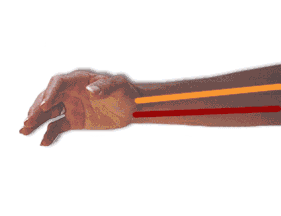 Pronation
or Working with the Hands Flat on the
Worksurface
Pronation
or Working with the Hands Flat on the
Worksurface
What is Pronation?
Pronation refers to the twisting of the forearm and as a
corollary the hand to a fully "palm down" orientation.
When the hands and forearms of an individual are
flat on a desk, such as when working on a conventional "flat"
keyboard or "flat" mouse, they have fully "pronated" their
hands and forearms. For most individuals, the posture that is
most comfortable is somewhere between 10° from the horizontal
(i.e. with the thumb side of the hand higher than the little
finger) and a vertical or "handshake" position (i.e. 90° from
the horizontal). Due to physiology, past injuries, or
developed conditions each individual will have their own
unique range of comfortable postures.
Why is Excessive Pronation a Risk Factor?
When an individual forces their hands to pronate to maintain
full contact with the input device, a Static
Load and strain is placed on the joints, muscles,
ligaments and membranes in the arm. That can lead to fatigue,
discomfort, pain and eventually injury. Just as excessive
pronation is something that individuals seeking to reduce the
risk of injury should avoid, excessive Supination
(over-rotating the hand past a vertical orientation towards a
palms-up orientation) can be an equally significant risk
factor.
What is the Best Angle to Position the Hand and Forearm?
As indicated earlier, each individual is unique and for some,
a near vertical posture will be most comfortable while for
others a near horizontal posture will be ideal. Unfortunately,
there is no "best" angle for everyone, and there are multiple
factors that need to be considered since what may be the best
angle for the elbow may not be for other muscle groups (e.g.
the fingers). For keyboarding, the tradeoffs of increasing the
angle beyond 20° typically make this the maximum viable angle
to ideally position the keyboard for most users (see Why
Does Vertical Mousing have Fewer Drawbacks than Vertical
Keyboarding). For mousing, there are not always
tradeoffs in moving to a more vertical posture, which makes
mice up to 30° a good option for almost all users, and mice up
to 90° an
option worth considering for many users.
How can a Keyboard Help to Reduce Pronation?
Keyboards which have a profile or design that allows the keys
to be physically higher in the center will result in a posture
which is less pronated (commonly called a "thumbs up" posture,
as the thumbs are now higher above the work surface than the
little fingers). Adjustable
Keyboards and Separated
Keyboards which offer the ability to tent or incline to
the desired angle of the user will greatly assist in the
prevention of excessive pronation while keyboarding. Some
Fixed
Split Keyboards also have a non-adjustable fixed
inclination which, if it happens to be the angle the user is
seeking and meets their other needs, would also serve this
purpose.
How can a Mouse Help to Reduce Pronation?
Mice which have a profile or design that allows,
encourages or forces the hand to be physically higher at the
index finger than on the little finger will result in a
posture which is less pronated. Typically these designs
provide a specific location for the thumb which allows it to
rest comfortably while the fingers are at varying degrees up
to a near vertical orientation. Orthopedic
Mice and Vertical
Mice always include a less pronated posture to provide
proper support and be orthopaedically neutral.
What Other Equipment can be used to Reduce Pronation?
A simple "do-it-yourself" solution is to place your mouse pad
on a binder with the rings on the binder closer to the midline
of the body. This will create a mousing surface which is
sloped with the thumb side of the hand higher than the pinky
side of the hand. Some Mousing
Surfaces incorporate this into their design.
Changing the mouse itself is a more effective solution since
mice of this design also generally incorporate additional
ergonomic improvements. As for the keyboard, there is no way
to reduce pronation when keyboarding if one is using a
conventional keyboard, unless the individual is willing to saw
their keyboard in half and re-solder all the connections to
make it functional again.

 Pronation
or Working with the Hands Flat on the
Worksurface
Pronation
or Working with the Hands Flat on the
Worksurface